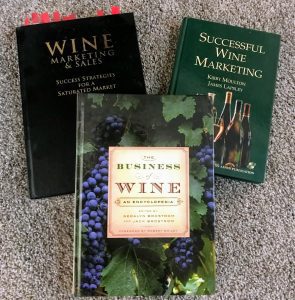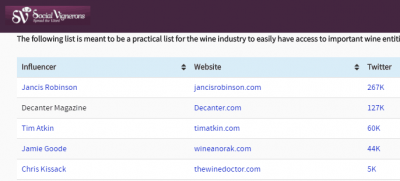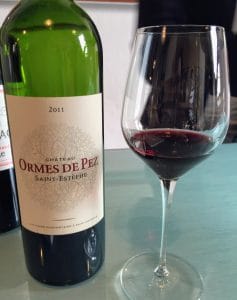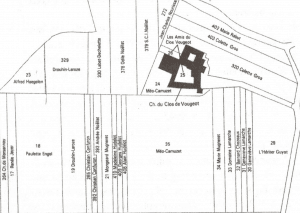 Social Vignerons just published their list of the 2018 Top 40+ Wine Influencers: Who to Follow on Social Media?. It’s worth taking a gander at.
Social Vignerons just published their list of the 2018 Top 40+ Wine Influencers: Who to Follow on Social Media?. It’s worth taking a gander at.
The value in gauging “influence” is always going to be imprecise. You can base it on the number of followers that one has on Twitter, Facebook and Instagram but that metric is easily gamed with purchased followers, bots and other “tricks.” Digital influence metrics like Klout scores have their own issues with Social Vignerons noting that they stopped using Klout for their rankings because changes in social media platforms have made the score less relevant.
What are Social Media Influencers?
A standard definition of a Social Media Influencer is “an individual who has the power to affect purchase decisions of others because of his/her authority, knowledge, position or relationship with his/her audience.” These include celebrities, recognized experts in a field, journalists, bloggers and “micro-influencers” who are regular people with a sizable social media following within a particular niche.
Marketers value these influencers because they believe that they can deliver on the 3 Pillars of Influences–Reach, Resonance and Relevance–to steer potential customers towards their brands.
Social Media Influences in the Wine Industry

Still got a lot of mileage and helpful info out of these books though.
In many ways, the use of social media in wine marketing and sales is Star Trek territory. Wineries and marketing firm are exploring strange new worlds where the old rules often don’t apply.
When I was working on my Wine Marketing & Sales degree at the Northwest Wine Academy and the Wine Business unit of the WSET Diploma Level, many of my wine business textbooks (such as Liz Thach’s Wine Marketing & Sales, Moulton & Lapsley’s Successful Wine Marketing and Brostrom’s The Business of Wine) gave scant to no mention of how to utilize social media. However, though Thach, Olsen and Wagner are releasing the 3rd Edition of Wine Marketing and Sales in May 2018 that may tackle the subject.
At the core of Marketing 101 is that to be successful you need to reach new customers so even if wineries have to learn how to utilize social media influencers via trial and error, it is still an endeavor worth taking. That is why lists like Social Vigneron’s Top Wine Influencers is worth looking into but it’s also worth thinking about critically as well.
What Influences Me?
As a married millennial adult with no kids and plenty of disposable income, I’m squarely in the crosshairs for many wine businesses. I also understand that I am influence-able and will spend money on new wines, travel to new wine regions, attend wine events, etc. based on interactions I have on social media. That is why I’m selective about the sources I follow because for a social media influencer to fulfill the 3 Pillars of Influence and “reach” me, they need to demonstrate Resonance and Relevance.
Resonance
Are you creating new content that excites me? I’m a wine geek. I want to read about new wines, wineries and regions. Sure, your opinion can be helpful in adding color, but everyone has an opinion. I need more than just that.
Some social media influencers don’t create new content but merely “retweet” or “repost” content created by others. That can be useful to some degree, especially if you are bringing to my attention something that I may have missed. But I often end up following and paying more attention to the original content creator than I do to the reposter.
And speaking of reposting, PLEASE don’t repost the same thing multiple times a day! Once, maybe twice, is fine after several hour intervals to hit online audiences that are active at different parts of the day but few things get me hitting the ‘Unfollow’ button quicker than seeing the same post tweeted out three times within a single hour.
Relevance
Be credible (i.e. “know your shit”) and be on topic. The first is easy. I’m not going to follow an account that passes off blatant errors and marketing crap as fact–like Champagne Masters and Their Bull Shit. The article that inspired that post came across my timeline via Food & Wine magazine. While I will give them a mulligan, I have no interest whatsoever in following any of the author’s social media platforms. But if Food & Wine keeps publishing shoddy pieces like that, then they will no longer reach me as a willing audience.
The second part of staying on topic is a little grayer. While I know we are all humans who lead multi-faceted lives, if you are going to be a Wine Social Media Influencer, be a Wine Social Media Influencer. A few comments here or there about trending topics is par for the course, but too many off-topic posts about politics, TV shows or posts about your pets gets boring quickly. The beauty of platforms like Facebook, Instagram and Twitter is that we can create multiple accounts to engage our varied interests. The short of it is this–I’m following you for your wine content which is the area you are most able to influence me so focus on that area instead of off-topic stuff.
My Social Media Wine Influencers

I am one of 267,000 that belong to the J-Hive.
Looking at Social Vigneron’s list, I saw many wine influencers that I already followed. But more than half were individuals that I’ve never heard of prior. I started following several of them, but if I find that I’m not getting any Resonance or Relevance, I will unfollow them and move on.
Among the ones on the list that I currently follow and have positively influenced me include:
Jancis Robinson — The Beyoncé of Wine, IMO.
Decanter Magazine
Tim Atkin
Jamie Goode — One of my favorite tools
Chris Kissack
Wine Folly
Vinepair
Alder Yarrow
Jon Thorsen
Wine Spectator
Wine Enthusiast
The common theme with all of the above is that they are content creators. These folks regularly produce compelling content that I want to consume. They also clearly “know their shit”. Other content creators not included on Social Vigneron’s list that I follow include:
The Academic Wino
Mike Veseth – The Wine Economist
W. Blake Gray
Terrorist
Jeff Leve — The Wine Cellar Insider
PalateXposure
Wine Business Monthly
Perhaps these lists will be updated to include some of the new names I discovered from Social Vigneron’s Top 40+. Just like with trying a new wine, I’m open-minded and hoping to be pleased. But if I’m not finding what I get very compelling, I have no qualms spitting it out.
 A few quick thoughts on the 2011 Château Ormes de Pez from St. Estephe.
A few quick thoughts on the 2011 Château Ormes de Pez from St. Estephe.





